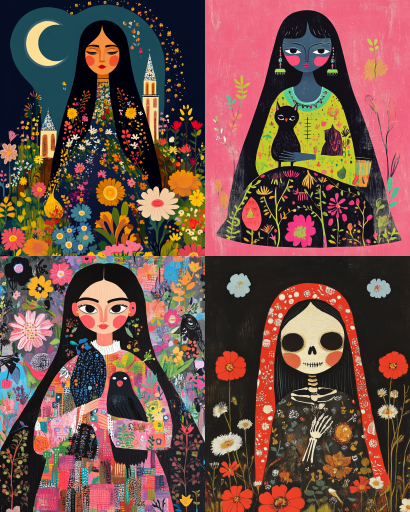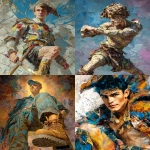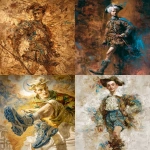Explore the Best AI Image Gallery

AI-Driven Visual Experiences: Transforming Creativity and Innovation
Artificial intelligence (AI) is revolutionizing the creative landscape, particularly through its ability to generate stunning visual experiences. From assisting artists and designers to reshaping how audiences interact with visual content, AI is influencing every facet of creativity. This blog post delves into the impact of AI on the creative industry, explores potential applications, examines ethical considerations, and highlights future trends in AI-driven visual experiences.
The Impact of AI on the Creative Industry
The creative industry has long been characterized by its reliance on human imagination and intuition. However, AI introduces a new paradigm where algorithms analyze vast amounts of data, learning patterns and styles that enhance creative outputs. AI-powered tools, such as Adobe Sensai and Daz 3D, are enabling artists and designers to accelerate their workflows by automating mundane tasks like image retouching and color correction.
Moreover, AI-driven algorithms can help create visuals that resonate with audiences by identifying current trends and preferences. For example, platforms like RunwayML allow creators to explore a plethora of styles, easily manipulating existing images and video content into something uniquely their own. As a result, artists can innovate their methods and push the boundaries of their creativity.
Potential Uses of AI in Visual Experiences
The potential uses of AI in visual experiences are vast and varied. Here are some key applications relevant to the creative sector:
- Content Generation: AI can be used to generate images, videos, and animations based on specific inputs. Tools like OpenAI's DALL-E and Midjourney allow users to create visuals simply by entering descriptive text, leading to endless creative possibilities.
- Augmented Reality (AR) and Virtual Reality (VR): AI enhances AR and VR experiences by providing interactive environments where users can manipulate visual elements in real-time. This interactivity opens up new dimensions in storytelling and audience engagement.
- Personalization: AI algorithms can tailor visual experiences to individual preferences, optimizing the way users engage with content. This is particularly useful in advertising, where personalization can significantly increase conversion rates.
- Design Tools: Graphic design software is increasingly integrating AI-driven features that help automate repetitive tasks, suggest layout adjustments, and enhance overall design quality. As a result, designers can focus on more conceptual work, elevating their output and efficiency.
Ethical Considerations
As AI continues to shape the creative industry, ethical considerations cannot be overlooked. The use of AI in visual experiences raises questions about authorship, originality, and the potential for bias:
- Authorship: Who owns AI-generated content? Is it the person who created the AI model, the user inputting commands, or the AI itself? Establishing clear authorship rights is crucial for preserving the integrity of the creative industry.
- Bias in AI: AI systems learn from existing data, which means they can inadvertently perpetuate societal biases. If historical data reflects biased viewpoints, AI-generated visuals may unintentionally reinforce stereotypes or exclude diverse representations.
- Quality Control: As AI technologies evolve, ensuring that the generated content meets quality standards becomes paramount. Lack of oversight can result in the dissemination of subpar or misleading visuals, eroding trust in content.
Future Trends in AI-Driven Visual Experiences
The future of AI in visual creativity is undeniably bright, with trends indicating an increasing integration of AI across various domains:
- Collaborative Tools: We can expect to see more collaborative tools that merge human creativity with AI capabilities, enabling artists and designers to work side by side with algorithms to create enhanced visual experiences.
- Advanced User Interfaces: Interfaces that facilitate seamless interactions between humans and AI systems will emerge, allowing for more intuitive user experiences when generating visuals.
- Real-Time Adaptation: The ability of AI systems to adapt visuals in real time based on audience feedback could revolutionize industries such as entertainment, gaming, and advertising by providing instant personalization and engagement.
- Expansion into Education: As understanding of AI tools grows, educational institutions may adopt AI-driven visual tools to teach creativity and design, emphasizing the importance of these technologies in modern artistic practices.
Conclusion
AI-driven visual experiences are fundamentally transforming the creative industry, redefining design processes, and opening new avenues for innovation. While the benefits are evident, it is essential to navigate ethical challenges as we integrate these technologies into our work. As we look toward the future, one thing is clear: the synergy between AI and creativity will create visually stunning experiences that captivate audiences and challenge conventional artistic expressions.




](https://images.ai-img.art/thumbnails/150/1614d64dd7156c95db952258978be809eb3db8cea4453fec69c49cbdfe63fa94.webp)
](https://images.ai-img.art/thumbnails/150/3a60737a5b67fa252207ad1ae6db245a26284f53fb5846996bb34515b39ff269.webp)






](https://images.ai-img.art/thumbnails/150/8c3bd422d50d35735d8fb33bd314a79e30e5b150129d5d09bdad822a2007593f.webp)